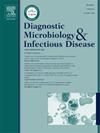NovaplexTM皮肤真菌qPCR检测皮肤和指甲材料中皮肤真菌和白色念珠菌的临床评价
IF 1.8
4区 医学
Q3 INFECTIOUS DISEASES
Diagnostic microbiology and infectious disease
Pub Date : 2025-09-12
DOI:10.1016/j.diagmicrobio.2025.117109
引用次数: 0
摘要
皮肤真菌感染通常是由皮肤真菌引起的,但也有酵母和其他非皮肤真菌霉菌引起的。这些真菌的微生物学诊断传统上依赖于直接显微镜检查(DME)和培养。然而,这些程序有重要的局限性。最近,一些市场上的qPCR方法已经出现,用于识别皮肤真菌和非皮肤真菌。在此,我们的目标是对NovaplexTM Dermatophyte RUO qPCR检测(Seegene)的临床性能进行正面评估,并与EurobioPlex Dermatophytes ce - ivd品牌qPCR检测(Eurobio Scientific)进行比较,用于检测皮肤和指甲材料中的皮癣真菌。2024年2月至7月,在西班牙潘普洛纳纳瓦拉大学医院收集了945名患者的998份样本(735份为指甲材料,263份为皮肤样本),用于皮肤真菌的分子研究。按照Seegene的说明进行DNA提取,随后执行两种qPCR方法。如果存在差异,则使用DermatoPlex qPCR测定(SpeeDx),在某些情况下使用二甲醚和培养结果。总体而言,NovaplexTM皮肤真菌检测在皮肤和指甲样品中的皮肤真菌和白色念珠菌分子检测方面表现良好;与EurobioPlex Dermatophytes试验相比,总体一致性为94.1%。忽略小孢子菌病例,仅检出59/998例(5.9%)差异。其中,大多数(62.7%)对NovaplexTM Dermatophyte试验评价阳性。与传统方法相比,认识到分子方法的敏感性增加,NovaplexTM Dermatophyte检测是一种可靠的qPCR诊断皮肤真菌病的方法。本文章由计算机程序翻译,如有差异,请以英文原文为准。
Clinical evaluation of the NovaplexTM Dermatophyte qPCR assay for the detection of dermatophyte fungi and Candida albicans in skin and nail material
Cutaneous fungal infections are usually caused by dermatophytes, but also yeasts and other non-dermatophyte molds. The microbiological diagnosis of these mycoses traditionally relies on direct microscopic examination (DME) and culture. However, these procedures hold important limitations. Recently, some marketed qPCR methods have emerged for the identification of both dermatophyte and non-dermatophyte fungi. Herein, we aim to perform a head-to-head evaluation of the clinical performance of the NovaplexTM Dermatophyte RUO qPCR assay (Seegene) in comparison to the EurobioPlex Dermatophytes CE-IVD-branded qPCR assay (Eurobio Scientific) for the detection of dermatophyte fungi in skin and nail material.
Between February and July 2024, 998 samples (735 were nail material and 263 corresponded to skin specimens) from 945 patients were collected for the molecular investigation of dermatophyte fungi at the Navarra University Hospital in Pamplona, Spain. DNA extraction was performed following Seegene instructions, and both qPCR methods were subsequently executed. In case of discrepancies, the DermatoPlex qPCR assay (SpeeDx) was used, along with DME and culture results in some cases.
Overall, the NovaplexTM Dermatophyte assay performed well for the molecular detection of dermatophyte fungi and Candida albicans in samples of skin and nails; with an overall agreement of 94.1 % when compared with the EurobioPlex Dermatophytes assay. Ignoring Microsporum spp. cases, only 59/998 (5.9 %) discrepancies were detected. Of them, most (62.7 %) evaluated the NovaplexTM Dermatophyte assay positively. Acknowledging the increased sensitivity of molecular methods compared to conventional procedures, the NovaplexTM Dermatophyte assay is a reliable qPCR method for diagnosis of cutaneous mycoses.
求助全文
通过发布文献求助,成功后即可免费获取论文全文。
去求助
来源期刊
CiteScore
5.30
自引率
3.40%
发文量
149
审稿时长
56 days
期刊介绍:
Diagnostic Microbiology and Infectious Disease keeps you informed of the latest developments in clinical microbiology and the diagnosis and treatment of infectious diseases. Packed with rigorously peer-reviewed articles and studies in bacteriology, immunology, immunoserology, infectious diseases, mycology, parasitology, and virology, the journal examines new procedures, unusual cases, controversial issues, and important new literature. Diagnostic Microbiology and Infectious Disease distinguished independent editorial board, consisting of experts from many medical specialties, ensures you extensive and authoritative coverage.

 求助内容:
求助内容: 应助结果提醒方式:
应助结果提醒方式:


